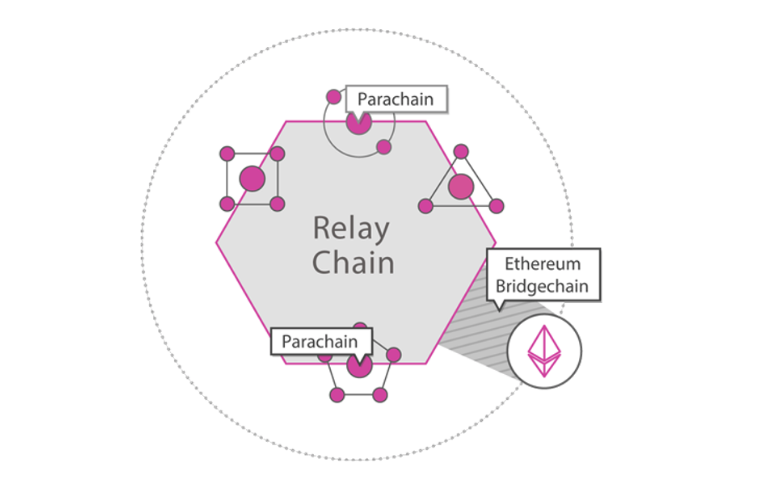
Blockchain has been around since the launch of Bitcoin. While it has been called a groundbreaking technology, there are also certain drawbacks to take into account.
Individual blockchains such as Ethereum and Bitcoin operate separately and are unable to communicate with each other. Developers have tried to “bridge” blockchains in the past which allows for example Ethereum blockchain to work with Bitcoin blockchain and vice versa. But connecting many blockchains at the same time remains a big issue.
Polkadot positions itself as the next generation blockchain protocol capable of connecting multiple chains into one universal network.
The two issues blokchain-based systems most need to solve to allow mass-adoption are:
- Scalability – the number of transactions per second the network can handle.
- Governance – how the community manages protocol upgrades and changes.
Polkadot aims to solve both of these problems.
What does Polkadot do?
- Polkadot is a “multi-chain network” that aims to connect different specialized blockchains into a single unified network.
- Blockchains that connect with Polkadot work in parallel as so-called parachains.
- This enables them to access the Polkadot network’s proof-of-stake validation of transactions and security.
Polkadot is a network designed to join the dots with all other networks. It’s commonly referred to as a multi-chain network, because it can join networks together, unlike networks like Bitcoin or Ethereum, which operates on its own.
Its ultimate aim is to act as a framework for all blockchains that opt-in, a bit like how HTML allows sites, browsers, and servers to interact with each other.
The team wants to focus its efforts on security, scalability and innovation. To do so, the necessary features of Polkadot are as follows:
- Specialization: Polkadot’s substrate framework enables you to create a custom blockchain easily. Each Polkadot parachain can be tailored to a specific use case or application. This ease of development should encourage more developers to participate in the system.
- Interoperability: By connecting all these different blockchains, Polkadot promotes unprecedented interoperability between these diverse ecosystems.
- Scalability: Polkadot supports multiple blockchains through a mechanism called “sharding” or parachains. This allows transactions to be processed efficiently and in parallel.
- Forkless upgrade: Polkadot can be upgraded without time-consuming and divisive hard forks; new features can be added without overhauling the network entirely.
- Improving security: Polkadot coin allows chains to interact with each other meaningfully while remaining independent enough to run their unique governance models.
Did you know?
One of the co-founder of Polkadot Dr. Gavin Woods, is also co-founder of Ethereum and wrote the Ethereum programming language, Solidity.
Parachain VS Relay Chain
An individual blockchain in the Polkadot ecosystem is called a parachain (parallel blockchain), while the main chain is called the Relay Chain. The idea is that parachains and the Relay Chain can easily exchange information at all times. You could think of parachains as being similar to individual shards in the planned implementation of ETH 2.0 (i’ll cover it soon).
The Bridge Chain connects different blockchains that don’t use Polkadot’s governance protocols.

Any developer, company, or individual can spin up their custom parachain through Substrate, a framework for creating cryptocurrencies and decentralized systems. Once the custom chain is connected to the Polkadot network, it becomes interoperable with all other parachains on the network and can access the polkadot network’s proof-of-stake validation of transactions and security.
Building cross-chain applications, products, and services should become a lot more straightforward with this design. Cross-blockchain transfers of either data or assets have not been possible on a large scale before.
Does Polkadot have a cryptocurrency?
Similar to most other blockchain infrastructure projects, Polkadot has its own native token. Known as DOT, it serves as the network token, just like ETH is the token for Ethereum and BTC is the token of Bitcoin.
- GOVERNANCE
This token allows holders to vote on potential code changes, which then automatically upgrade across the network if a consensus is reached.
Token holders have complete control over the protocol.
These changes can include determining network fees, voting on overall network upgrades, the deployment or removal of parachains.
2. CONSENSUS MECHANISM (Proof of Stake)
Since Polkadot is based on the Proof of Stake consensus protocol, DOT token is also designed to facilitate network consensus through staking. Similar to other networks that involve staking, all DOT holders are incentivized to play by the rules at all times. How are we sure they will do that? Well, if they don’t, they could lose their stake.
Remember in our Proof of Work(PoW) /Proof of stake (PoS) article.
Staking tokens on a blockchain network is not a new concept. Known as PoS, this consensus model works by rewarding users for staking coins on the network. With Polkadot, honest stakers are rewarded, while bad actors can lose their entire stake.
3. BONDING
The third option is to use DOT for bonding. This is required when new parachains are added to the Polkadot ecosystem. Every new parachain is added by bonding DOT tokens.
Bonding refers to committing tokens to the network for a specific period of time. Chains that aren’t useful or projects that are no longer maintained will be removed, and their bonded tokens returned.
My thoughts
I love Polkadot. These unique features are partly why many consider Polkadot to be one of the most promising and well thought-out projects in the blockchain space. The underlying technology makes its case as one of the most important and eye-grabbing projects out there. It will be interesting to see what Polkadot does in the future.
Important to know that Polkadot has enjoyed a successful launch, and surged to become the fourth-biggest cryptocurrency by market cap in a remarkably short space of time. Now, it faces the challenge of building on that success and fending off the competitors nipping at its heels.
After all, it’s not the only platform focusing on improving scalability, governance, and interoperability.
Polkadot’s biggest competitor is Cosmos. Cosmos has been working on blockchain interoperability since 2014. Read my Cosmos article here 🙂.
As always feel free to leave a comment down below for any question you have about this article and I’ll be answering! Remember, we are all here to learn and there are no stupid questions 🙂
Thank you !



